
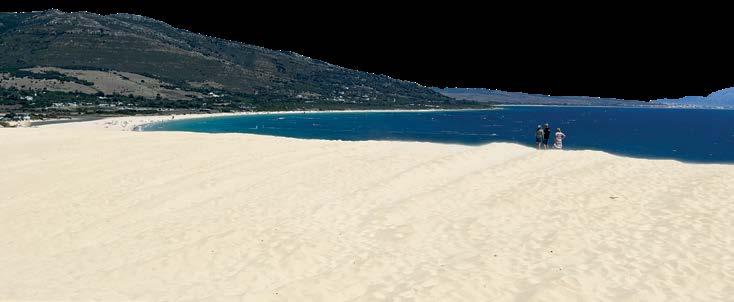







England goalkeeper, 23, who spent much of her childhood living in Spain, pulled off two massive saves in a heart-stopping penalty shootout victory over Spain
It allowed the Lionesses to secure back-to-back European Championship titles and earned revenge after Spain beat us in the World Cup two years ago. And if that wasn’t
enough, the Birmingham-born star stunned reporters by giving her postmatch interviews in fluent Spanish.
Her linguistic skills garnered cheers from fans on both sides of the pitch and went viral online.
With Spanish fans left speechless and English expats swelling with pride, Hampton is being hailed as the ‘bilingual brick wall’ who shut down Spain’s Euro dreams.
The Brummie spent five formative years in Spain, moving there with her teacher parents at age five.
Continues on Page 3

BRITAIN’S most notorious far-right agitator, Tommy Robinson, is on the run – and likely headed back to Spain, the Olive Press can reveal.
By Dilip Kuner & Adam Husicka
“He could be flying via somewhere else, but he is a creature of habit and he’s got a lot of pals on the Costa Blanca, who protect him.”

The ex-English Defence League (EDL) boss allegedly fled the UK yesterday morning after being filmed (see right) ranting beside an unconscious man at London’s St Pancras station.

The man had been knocked out, with shocking footage later showing blood on the floor and medics trying to resuscitate
him.
Robinson, real name Stephen Yaxley Lennon, was heard saying: “You saw him come at me, bruv,” before fleeing. British Transport Police confirmed the assault and revealed the victim remains in hospital with serious injuries.
Now, Olive Press sources say Robinson, 42, boarded a flight just hours later and is ‘likely’ returning to Spain, where he’s been based for months. “Realistically he’s likely to be heading for Alicante where he will start to desperately cobble together his defence,” said the source, who knows him well.
FED-UP locals in the Balearic Islands are packing their bags as mass tourism sends housing costs soaring and quality of life plummeting.
A bombshell report by the Mutua Propietarios Group found just 29% of residents would stay if they had the chance to move elsewhere in Spain. With towns overrun and rents sky-high, nearly six in ten want out – most eyeing Andalucia, followed by the Basque Country and Navarra. Even worse, only 3% of Spaniards see the Balearics as a desirable place to live, showing the stark divide between the islands’ postcard image and the harsh reality for locals. Protests have rocked hotspots like Mallorca, where angry residents say overtourism has turned thriving resorts into “ghost towns.” Many complain they can no longer afford to live
He continued: “He’s probably dumped his phone to throw the authorities off his trail.”
We can reveal Robinson recently stayed in Finestrat, near Benidorm, where he ‘rented’ properties in the Campana Gardens development.
The project is mysteriously linked to Russian investors and promoted by fellow far-right UK watch dealer-turned-influencer Paul Thorpe.
Robinson also spent time in Tenerife, where he ‘stayed in a €1.5 million villa’ near Adeje and later at the exclusive Quinta do Lago resort in Portugal, where he was last Christmas.

In fact, Robinson – despite being bankrupt – has used dozens of luxury properties across the Iberian
KNOCKOUT: Robinson (in blue) tells fellow traveller ‘He came at me’
Peninsula as boltholes.
The serial fugitive has repeatedly used Spain and Portugal to escape British legal troubles.
As we reported last year he stayed at a luxury villa in Albir, where he filmed a string of podcasts before socialising with German neo-Nazi Lutz Bachmann in Tenerife.
In another Olive Press expose, we re-

vealed that the stunning €1.5 million property was
by British fashion mogul Philip Day – the billionaire behind Edinburgh Woollen Mill and Peacocks. The Olive Press revealed he used the property as a studio for far-right podcasts, including collaborations with American far-right Proud Boys founder Gavin McInnes. After knocking on the
British far-right thug vanishes after UK assault – and is ‘likely’ coming to Spain

villa, Robinson threatened Olive Press reporters, saying: “See if you like it when I knock on your mum’s door.”
Robinson meanwhile has also lived in Marbella, where he posted from the exclusive Manolo Santana Racquets Club.
He also spent time in Gibraltar, where he was considering living for a while.
The latest incident – and his rapid disappearance – raises fears among locals and officials of yet another round of drama on Spanish soil.
Though the Guardia Civil has not commented, pressure is likely to mount if Robinson attempts to return and use Spain once more as his safe haven.
If UK police find sufficient grounds, an Interpol Red Notice could follow.
Page 6


Extract from complaint currently being dealt with by Oslo Conciliation Board –Dept. 4 Case No. F2024-001911
Complainant: Kredinor Finans As, Postboks 782 Sentrum, 0106 Oslo, Org.Nr. 00919628103
Defendant: Daniel Omar Perez Fornassero. Sist kjente adresse: Calle Italia, 13, Puerta 26, Es-38109 Santa Cruz De Tenerife, Spain
The Complainant has filed a complaint against the Defendant with Oslo Conciliation Board with a demand for payment of NOK 101126,01 with the addition of interest at the legal rate and legal cost
The Defendant is ordered to reply to the Conciliation Board in writing by 03.09.2025 stating whether or not the Defendant acknowledges and accepts the Complainant’s claim. If a reply has not been delivered prior to the expiry of the stated time limit, judgment by default can be pronounced on the basis of the Complainant’s representation of the facts of the case.
As the Defendant has no known address, service will be executed with authority in the Courts Act Section 181. The complaint and order to reply will be deemed to have been legally served when it has been posted at the legal venue for four weeks.
The documents pertaining to the case can be collected from the Conciliation Board’s offices at Pilestredet 19, 0033 Oslo, Norway. The documents can be sent to a new address supplied by the Defendant if the Defendant so requests.




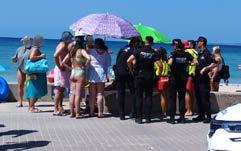
A SHARK alert got bathers scrambling for the shore on part of Playa de Palma last week.
An elderly Italian bather was bitten in the water and lifeguards unsure about the creature responsible raised red flags for around an hour.
The 85-year-old victim was missing a portion of skin with blood pouring out of her left calf.
Tension rose as guards went round telling people to get out of the water.
One of the team even used a loudhailer to say that bathing was prohibited due to a shark attack.
Some of the lifeguards used a motorboat to go around the area to see if a shark was around , but found nothing. Experts said images of the injury suffered by the Italian tourist did not match those of a blue shark - with no shark attacks ever being confirmed on Mallorca.
By Ben Pawlowski
MORE secrets of the Franco dictatorship are to be brought to light as the government pushes ahead with reforms to the Official Secrets Act.
A proposed law will now lift censorship on all files labelled as ‘top secret’.
The draft bill will apply to all documents classified prior to 1981, which includes the fascist dictatorship of General Franco (1939-1975) and the transition to democracy (1975-1982). Under the legislation, files labelled as ‘top secret’ will be made public after 45 years,
‘with the possibility of an exceptional and justified extension for a further 15 years’. Meanwhile, ‘confidential’ texts will take up to nine years, and ‘restricted’ files up to five years. The measure,

which brings secrecy laws in line with the EU, will help shine a light on human rights abuses during the Franco era. Under the dictatorship, Spain experienced widespread censorship and repression. The regime tightly controlled
A BRITISH tourist was found dead in a Mallorca hotel swimming pool on Tuesday.
Staff at the unnamed s’Illot hotel discovered the body of the 52-year-old man floating face down in the water.
Emergency services were called at 8.30am but paramedics were unable to revive him.
The hotel guest appeared to have suffered a cardiac arrest.
the press, literature, film and education, banned dissenting views and promoted its fusion of nationalist, Catholic and fascist ideology. Opponents were persecuted, with many imprisoned, executed or forced into exile. Transparency over abuses was further complicated by the subsequent transition to democracy.
The country was guided by the so-called pacto del olvido (‘pact of forgetting’), a nationwide consensus that sought to put a lid on past atrocities to heal deep national wounds. Now, the socialist-led government of Pedro Sanchez wants to reverse that process of collective amnesia, after signing an agreement with the Basque Nationalist Party (PNV) earlier this year.
SPAIN’S remarkable economic performance shows no sign of slowing down after the country hit its lowest rate of unemployment since 2008
According to the National Statistics Institute (INE), Spain’s unemployment rate has fallen to 10.29%.
It marks a dramatic recovery from 2013, when joblessness peaked at nearly 27%.
The number of people in work has hit a record 22.27 million, with over 500,000 jobs added between April and June, mostly in hospitality, manufacturing and commerce.
A GUARDIA Civil officer

Up till now, individuals wanting to unearth files had to request declassification on a case-by-case basis, accompanied by detailed justification. Successive governments have also been reluctant to implement reforms, complaining that declassifying documents represents a massive bureaucratic task.
Once given the green light by the Council of Ministers, the bill will head to Congress where it will be debated before a vote is taken in Congress.
The 32-year-old aggressor of unknown nationality was bailed by a judge after being charged with attacking a police officer.
The man - along with his wife and sonhad flown in late one evening. They went to their carrier’s information desk to complain about all of their luggage going missing.
The office was closed and the irate traveller banged on the front door - displaying a ‘violet attitude’, according to the Guardia Civil.
Two officers tried to calm him down but he became even angrier.
He then pounced on one of them in a fullblown scuffle where he bit the officer.
A DRUNK British tourist was arrested in Playa de Palma after punching a Policia Nacional officer in the jaw. The 29-year-old had only just arrived in Mallorca on July 22 and hadn’t even checked into his hotel before the assault. Drunk and shirtless, he approached two plainclothed officers, mocked one, and made offensive gestures. When the officer showed his badge and tried to walk away, the Brit suddenly punched him in the jaw, causing a wound that required stitches. Three officers were needed to subdue him. He was arrested for assault and disobeying police, and appeared in court the next day. A judge imposed €3,000 bail and confiscated his passport.
SPAIN has become the EU’s number one destination for asylum seekers after overtaking Germany.
New figures show Spain received 12,800 asylum applications in May, compared to Germany’s 9,900. The shift follows a sharp decline in Syrian asylum claims, previously the largest group in Europe, after the fall of Bashar al-Assad in December.
Spain’s rise is largely driven by Venezuelan migrants fleeing political and economic turmoil, with some reportedly diverted by US immigration crackdowns.
Small boat arrivals to the Canary Islands have dropped dramatically in 2025, though 60,000 reached Spain in 2024. Italy is now second with 12,300 applications, followed by France. Overall EU asylum claims dropped 25% year-on-year.

playground kickabouts led to a trial at Villarreal FC - where she became a striker whose fluency in Spanish developed alongside her talents.
That early exposure to Spanish football philosophy - tight passing and technical skill - helped shape her style. She credits her ball-playing ability and distribution as strengths rooted in her time in Spain
The 1-1 final had already delivered 120 minutes of drama. But it was penalties where history was written.
After Beth Mead’s early miss, all eyes turned to Hampton – and she didn’t flinch.
Hannah saved back-to-back penalties from Mariona Caldentey and Ballon d’Or winner Aitana Bonmati, giving England the edge.
“Today I played against the country I still call home,” Hampton told Spanish media after the match, flashing a smile and switching seamlessly between languages.
“But my heart’s with England – and I’m so proud of what we’ve done.”

TEuro final against Spain could be heard from halfway up the main boulevard of San Pedro Alcantara.
As we made our way towards the echoing chants of Three Lions on a Shirt, we knew this Irish Pub was the place to watch.
Nerves were high at the rickety trestle tables outside, where most were backing England –except for one Spanish family and, of course, the Irish pub owner, who sported a bright red Spain shirt. In true form, we ordered two pints of Guinness and tried to ‘split the G’, which, combined with pre-match ban-
ter, got everyone in the mood.
The pub fell silent as the whistle blew, and then came the groans when Mariona Caldentey scored for Spain in the 25th minute.
The mood shifted, and the Spaniards, understandably, turned to teasing us with cheeky chants and smirks.
All in good spirits and, in response, we ordered more Guinness – and a mountain of nachos topped with an unexpectedly delicious chilli con carne.
When good old Alessia Russo netted the equaliser in the 57th minute, the crowd erupted. Our cheers echoed through the street. No, the town, confusing and likely
DIFFERENCE BETWEEN

horrifying a few passing locals.
As the match wore on, tension mounted. With every pass and missed shot, we clenched our pints tighter, casting nervous glances at the screen. Extra time meant another Guinness, of course, and as the dreaded penalties approached, fans from both sides looked on nervously. A roar of relief went up when Salma Paralluelo sent her penalty wide. But just as Chloe Kelly stepped up to seal En gland’s 3-1 win, disaster struck – the screen cut to black. It was

Spanish PM caught in steamy slur while Women’s Euros deliver the real drama
IT must be summer in Spain when the man who’s held the country together since 2018 - often by the skin of his teeth - turns up at the Cortes Generales for a day’s hard legislating, only to be accused by the opposition of being a pimp!
Yes, really. Poor old Pedro Sanchez. Just when you thought Spanish politics couldn’t get any more theatrical, along comes a plotline worthy of Shakespeare - or at least a steamy Netflix mini-series. Spain’s Prime Minister and his wife Begoña are being accused of living off the proceeds of prostitution. The opposition claim that Begoña’s late father’s company, Sabiniano, once owned a few brothels and gay saunas.
There’s been an official investigation (which found nothing dodgy), but that hasn’t stopped the conspiracy mill grinding on. The couple own a couple of nice homes, so naturally, some are convinced they’re secretly raking it in from sex work. You’ve got to hand it to the opposition - if you’re going to sling mud, sling the juicy stuff. Forget the costof-living crisis, national debt, or the state of public health. No, let’s go straight in with: ‘The PM’s a sex criminal!’ Theatrics like this almost

make you wish the UK Parliament had a little more Spanish flair. At least voters might feel they’re getting their (tax) money’s worth in drama.
Speaking of high drama - what about the Women’s Euros?
Whether you’re Spanish or English, that final was a cracker. No prima donna tantrums, no Z-list celebrity behaviour - just raw talent and proper football. The skill on display would put many top-flight men’s teams to shame.
Sunday’s match wasn’t just great sport - it was played with real spirit, grit, and respect. Every player left it all on the pitch. Someone had to lose (sadly), and although I now call
Spain home, I’ll admit I was still quietly cheering on the Lionesses. And what about the head coach, Sarina Wiegman? With all the money that’s been trousered by foreign supposed super-star coaches over the years in the men’s game, what a legend!
I’m sure all the players will get medals of some kind very soon, but what about the Dutch coach who has masterminded two Euro championships, and got her team to the World Cup final? If ever there was a case for the awarding of an honorary Damehood, Sarina must be a dead-cert!
Well, that’s my deadline made for another week, so I think it’s time for a little siesta. For some reason I seem to have a bit of a headache today! But what a night! What a game!


a warm handshake ahead of the match.
Charlotte was accompanied by her father, Prince William, who was seen chatting with the Spanish sisters before kick-off. Leonor and Sofia, who both studied at top UK boarding schools, are fluent in English, making conversation easy. Despite Spain’s loss, the Spanish royals were all smiles. After the final, Leonor and Sofia visited the La Roja dressing room to offer their commiserations and praise the team’s performance.


Voted top expat paper in Spain
A campaigning, community newspaper, the Olive Press represents the huge expatriate community in Spain with an estimated readership, including the websites, of more than two million people a month.
ONCE again, Tommy Robinson is in flight – and, once again, all signs point to Spain.
The far-right firebrand, whose real name is Stephen Yaxley Lennon, allegedly fled the UK just hours after being filmed next to a seriously injured man at London’s St Pancras station. Now, the Olive Press can confirm he is ‘likely’ holed up somewhere along the Costa Blanca –a region he knows well. Or he will be here soon! Let’s be clear: Robinson is no political dissident. He is a convicted criminal with a documented history of spreading hate, provoking violence and dodging accountability. His rap sheet includes fraud, assault and contempt of court. Yet time and again, he has slipped into Spain, enjoying the sun while escaping the consequences of his actions. Why? Because he knows Spain has been soft on him. From a luxury villa in Albir to rented pads in Finestrat, and podcasts filmed with neo-Nazis in Tenerife, Robinson has used the Iberian Peninsula as his personal hideaway. His connections run deep – from UK influencers to shadowy investors. Enough is enough.
Spain cannot continue to be a convenient bolthole for extremists and criminals.
While the vast majority of British expats are honest and law-abiding, Robinson is neither: He represents a dangerous ideology, one that corrodes democracy and spreads fear. If he is on Spanish soil again, authorities must act decisively. Investigate. Arrest. Deport. Spain is better than this. We are not a haven for hate, nor a playground for fugitives.
Tommy Robinson may believe he can lie low here once again. But this time, Spain must prove him wrong – for good.
PUBLISHER / EDITOR
Jon Clarke, jon@theolivepress.es




Dilip Kuner dilip@theolivepress.es Walter Finch walter@theolivepress.es
Yzabelle Bostyn yzabelle@theolivepress.es
Samantha Mythen samantha@theolivepress.es
Tom Ewart Smith tom@theolivepress.es
ADMIN Victoria Humenyuk Makarova (+34) 951 154 841 admin@theolivepress.es

Alex Trelinski alex@theolivepress.es
Joshua Parfitt josh@theolivepress.es
Dylan Wagemans dylan@theolivepress.es
OFFICE MANAGER
Estefania Marquez (+34) 658 750 424 accounts@ theolivepress.es



DISTRIBUTION ENQUIRIES (+34) 951 154 841 distribution@ theolivepress.es




SIXTEEN and seventeen-year-olds will be able to vote in the next UK general election, following a landmark decision by Sir Keir Starmer’s Labour government -marking the biggest expansion of the British electorate in decades.
But while ministers hail it as a step toward greater democratic inclusion, some critics are warning that the UK should look carefully at Spain before assuming young voters will always back the Left.
Deputy Prime Minister Angela Rayner defended the move, saying it will “get democracy back on track” and give teenagers “a stake in our country’s future.” She argued it was unjust that 16-year-olds in England and Northern Ireland are denied voting rights enjoyed by their counterparts in Scotland and Wales.
Writing in The Times, Rayner said: “There are many 16-year-olds across this country who are working, paying taxes, and even serving
By Ben Pawlowski
Labour's youth vote gamble faces stark warning from Spain’s political shift

in the armed forces. Why shouldn’t they be trusted with a vote?”
Yet while Labour appears confident the policy will translate into greater youth support at the ballot box, analysts are pointing to a cautionary tale from Spain - where the Left’s assumptions about young voters have been upended.
Spain’s far-right party Vox has become the most popular choice among voters aged 18 to 24, with over 27% of this group backing the nationalist outfit, according to polling by 40dB. That’s more than Spain’s centre-left PSOE (Labour’s sister party) and its left-wing allies

MOVE over Pedro Sanchez – there’s a new sheriff in corruption town.
The various scandals engulfing the prime minister have been knocked off the top spot by a new case gripping




This dynamic is not unique to Spain. Simi lar patterns are emerging across Europe, where disillusioned young men are gravitat ing toward nationalist and populist move ments. Vox’s rapid growth in Spain suggests that political identity among youth is more fluid and less predictably progressive than many on the Left might assume.
Reform UK leader Nigel Farage has accused Labour of trying to ‘rig’ future elections by ex panding the franchise to an estimated 1.6 million young people.
“ Among males aged 18 to 28, nearly onethird say they would vote for the far-right party
combined. By contrast, only 11% of voters aged over 65 support Vox, revealing a generational reversal in political trends. The appeal of Voxknown for its hardline stance on immigration and Spanish identity - is particularly strong among young men. Among males aged 18 to 28, nearly one-third say they would vote for the far-right party. It’s a sign that the populist right is not just a force among older generations but is increasingly resonating with younger voters, especially across social media platforms.
His party, traditionally more popular among older Britons, has recently stepped up its ef forts to connect with younger demographics via TikTok Instagram - mirroring the dig ital strategy that has helped propel far-right movements in Spain and beyond.
A recent YouGov poll shows Labour leading among 18-24-year-olds in the UK, with 28%, followed by the Greens (26%), Lib Dems (20%), Conservatives (9%) and Reform UK (8%).

But if Spain’s experience is any guide, those figures may not hold. As online influence and nationalist narratives gain traction with younger voters, Britain could see its own version of the Spanish youth shift - potentially turning Labour’s electoral reform into a double-edged sword. The question facing Labour now is not just whether young people will vote - but who they will vote for. And Spain’s political transformation suggests that age is no longer a reliable predictor of progressive politics.
There’s a new chart topper in Spain’s all time corruption scandals - a €2.2 billion whopper in one year alone… set up by a former treasury chief
By Walter Finch

Spain.
Roll over ERE and Gurtel (ED: some of you will need to look these up), this is a monster


case, which is already taking the attention away from Spain’s beleaguered leader.
The claims centre on former PP finance minister, Cristobal Montoro, who headed the Treasury from 2000 to 2004 and from 2011 to 2018 under former leader Mariano Rajoy. Montoro allegedly exploited his position to helm a network that re -
wrote tax laws to benefit gas companies in exchange for cash in the form of ‘consulting fees’.
Prosecutors estimate his schemes delivered a fiscal windfall – and deprived the Treasury (aka Hacienda) – of roughly €2.2 billion in 2012 alone, while five large conglomerates saved at least €51 million.
Later, from 2014 to 2018, a firm owned by Montoro allegedly acted as a well paid go-between for a string of petroleum giants and pals of his at the Treasury. The parties colluded to reform the tax rules and in return these companies paid out around €50 million timed to coincide with each successive legislative tweak.
phones were tapped for 42 days back in 2021.
The investigation spans the former minister’s two terms in office, first under Jose Maria Aznar and later with Mariano Rajoy, and reaches deep into the heart of the Treasury.
Exploited his position to helm a network that rewrote tax laws
A judge has now indicted Montoro alongside 27 co-conspirators for ‘influence-peddling’ with the aim of lining their own pockets. It comes after judge Ruben Rus ordered that four tele -
Among those charged are eight senior ministry officials accused of drafting or approving the legislation, three successive director generals of taxes, and several ex-partners of Montoro’s firm, Equipo Económico who once held government posts. Prosecutors allege that the petroleum giants channelled payments through Montoro’s consultancy, with some sums coinciding exactly with the years in which favourable reforms were passed. Further down the list are construction and renewables firms that also sought faster payments or lighter levies. The scandal even ensnares

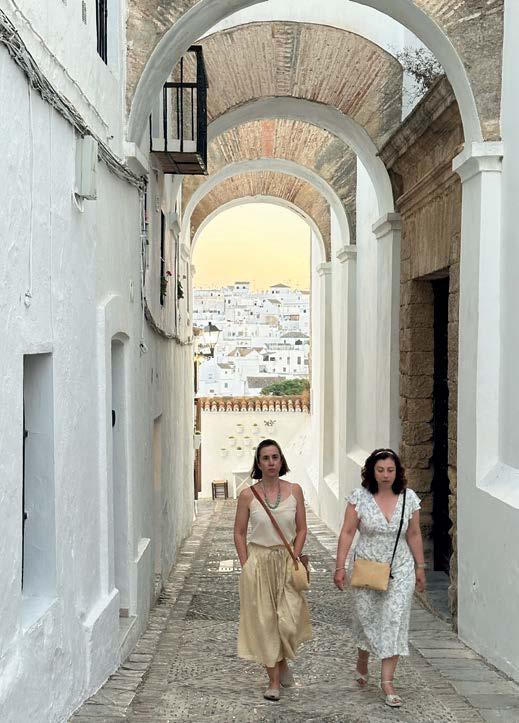
WHILE it’s blowing a hoolie outside and well over 35 degrees in the sun, I’m sitting in deep shade and wondering what amazing culinary creation is going to appear next on my table.
This is La Traina, in Zahora, one of the true dining secrets of Andalucia.
Tucked away down a scruffy potholed lane somewhere between Vejer de la Frontera and Zahara de los Atunes you are not going to find it by accident.

Southern Spain’s most evocative coastline is bright, breezy and brilliant for walking, eating and watersports, writes Jon Clarke


THE Costa de la Luz’s celibrated culinary prowess is down to the local surroundings, which produce some of the best quality in- gredients in the world.
The obvious examples are sherry, fish and the wonderful beef from the classic brown ‘retinto cows, which you often see wandering around in the hills and even on the beaches.

By Jon Clarke

And don’t expect silver service and menus in English or German…This is, after all, the Costa de la Luz - the Coast of Light - and a million miles away from its nearby cousin the Costa del Sol. Indeed the costas in general. This is a coastline of castles and carpaccios, calas and corvina (one of its
best local fish)... the perfect blend of nature and its best ingredients. This is a coastline of gems; histor ic Tarifa, the bridgehead for the Moors in Spain, and a crossing point for centuries and beautiful Vejer, with its cobbled streets and dynamic restaurant scene. This is a coastline of laid
Of course the amazing ‘almadraba’ bluefin tuna (top), caught nearby (above), is spectac- ularly good and the vegetables available are also of a high quality, particularly from Conil. Another reason is the type of tourists who visit the coast, which has seen a distinctly more refined crowd than its nearby rivals on the Costa del Sol. They demand quality and are pre- pared to spend to get it.



back, low rise resorts; Roman Bolonia and the biggest sand dune in the world, entertaining El Palmar, with its party
crowd and surf, and alternative Canos de Meca, with its quirky, laid back feel. But what best sums up this long stretch

of coastline for me is restaurants like La Traina, or other hidden spots like Patria, Castelleria or Punta Sur.
These are right at the top of their game and all sit in leafy gardens, often high in the hills and sometimes with views to die for.
But even better they are surrounded by southern Spain’s most evocative stretch of coast, a canvas of contours and colours, a backdrop of Africa, and all illuminated by the most extraordinary changing light.
It’s everything you could want for a beach holiday: Long, unspoilt (and often empty) beaches, windswept sand dunes and a smell of mimosa and rosemary, alongside shady umbrella pines. Practically unique to Spain these days, and sadly busier and busier each summer, what you really need to do is ex-

One of my favourite drives is the 15 minute journey from Zahara to Barbate. I actually walked it this Spring, but you’ll need a couple of hours.

A genuine tardis between two worlds, Zahara is the quintessential home of affluence; a golden magnet for stylish restaurants and a flotilla of Range Rovers and Teslas come peak holiday season.
In contrast, Barbate is a new town created by dictator Francisco Franco, a pockmarked working class place with high unemployment and ugly 1960s tower blocks. What they share though, is privilege. A surrounding patchwork of greenery and long, unspoilt beaches, only broken up by inlets from the sea and a forest of pines. This is what much of Andalucia’s coastline

From the


would have looked like half a century ago, with only the Cabo de Gata in Almeria coming near to match its beauty.
What this stretch of coastline has in particular though is a

FORTIFICATIONS: Tarifa
variety of ancient and historic towns and villages.
Laid back and unshowy, its friendly, unfussy locals complement the breathtaking scenery and distinctive vibe.
Vejer, in particular, has an incredible mix of stylish boutique hotels and one of the best selection of high quality eateries in all of Andalucia (see overleaf).
Tarifa has an altogether different feel. This is a town for watersports lovers and a place to party, especially in summer, when it is heaving with buzzing nightspots open until the early hours.
But it also has a melting pot of worldly Spaniards and expats, who make for a distinct Tarifa scene, also with its fair share of restaurants and shops.
It is also one of the few towns in southern Spain – thanks in large to its wind – that still has a bit of life in the winter.
It also has a fair share of history with the Moors first arriving
in Tarifa in 710AD making it their main bridgehead into southern Spain.
The Moors ruled this land for nearly 800 years and its historic ramparts are littered with references to the stirring catholic heroes who battled them, some with statues, including Sancho El Bravo and Guzman el Bueno.
There’s a kind of untouched purity to the place
You’ll love its ancient old town gateways, and the narrow cobbled streets of its old town, which still include an ancient fish market and plenty of fascinating buildings.

Heading up the coast from Tarifa, history lovers must seek out the famous Trafalgar lighthouse – off which the key naval battle once took place as well as the
ancient fishing village of Sancti Petri, near Chiclana. Chiclana’s eight kilometres of golden beach meanwhile remain refreshingly uncrowded - populated mostly by Spanish families from inland cities like Sevilla. There’s a kind
of untouched purity to the place. The town centre offers a maze of Moorish-era alleys and historic buildings, like the clock-tower gate of Arco Torre del Reloj. Next door Conil meanwhile is an attractive place that hugs its own beach.
Renowned for the local seafood it was crowned the 2024 Gastronomic Town of Spain and also has a vibrant nightlife scene.
Look out for the Torre de Guzman, an old military fortification dating back to the 14th century.
SECRET SPOTS
One of my favourite must visits on the Costa de la Luz are the Roman ruins at Bolonia.
This well preserved museum showcases the success Roman merchants had on this stretch of Cadiz coastline and the nearby beach and its giant sand dune warrant a half day at least.
Best of all, is the half an hour walk from Bolonia to secret El Canuelo beach, where you will find just cows, the celebrated brown retinto kind of the region. I also love the amazing walk through umbrella pines to the Torre del Tajo,


nia. And, if you are still looking for more, how about San Fernando?
This is where Camaron de la Isla, the legendary flamenco singer, hails from. His childhood home now functions as a somewhat sanitised museum and this is a little-visited town with plenty of in-

THE Costa de la Luz officially stretches for around 200kms all the way from Tarifa up into Huelva and to the border with Portugal.
whitewashed homes sit beside an imposing American naval base - one of the largest in Europe.
And let’s not forget the grand old city of Cadiz, said to be Spain’s most ancient and big back in Phoenician time. Oh the incredible lightness of being! teresting nooks and crannies. Further west, Rota offers an unexpected blend of beach life and military might. Here,

Split in two by the stunning Donana national park, the coastline also includes the so-called 'sherry triangle' or 'Cadiz coast' towns of Sanlucar de Barrameda, Rota, Chipiona and El Puerto de Santa Maria. It also includes the cities of Cadiz and Huelva.




THERE isn’t much Alberto Reyes doesn’t know about food…so it’s appropriate he’s at the frontline of fine dining in Vejer. His restaurant, 4 Estaciones, is at the epicenter of one of Andaulcia’s nervecentres to eat.


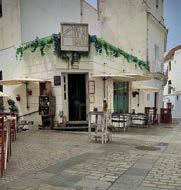

Open since 2017, it’s impossible to dine badly in his joint which is as attractive on the eye as it is tasty on the stomach.
Much of this is thanks to his careful selection of chefs, with his latest signing, Esperanza Macias, having trained at Andalucia’s top restaurant, Aponiente, which counts on three Michelin stars, at nearby El Puerto de Santa Maria.
“You need to continually up your game here and keep trying new things,” ex-




Jon Clarke explores why Vejer de la Frontera has become the food capital of Cadiz drawing in culinary tourists from around the world
ucts and change them by the season and always hire talented chefs in the kitchen.”
But even then, there is no guarantee you will survive, with the town continually evolving and refining its range of restaurants.
plains Reyes, who grew up locally and previously ran the highly-rated Arohaz, in nearby Canos de Meca.
“You need to understand how to use local prod-
“In fact, they should be doing a university course on the success of Vejer’s food revolution,” continues Reyes, who is speaking at an interior table of his charming joint surrounded by books on cuisine from all corners of the globe.
jer, which counts on around a dozen of entries in the latest Repsol dining guide for Spain. While many are in its nearby environs (or greater Vejer) including Canos de Meca and El Palmar, the centre of Vejer is the place to start.

It says a lot about his mindset, which might be local in terms of produce but is clearly extremely global in terms of ambition.
He is one of many success stories in Ve-
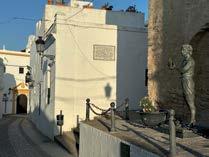
Take recent arrivals Jaime and Alejandra, whose restaurant Narea landed a much sought after Repsol Sol in under a year. A charming spot on the prestigious Corredera street with the most breathtaking views helped, but what sets it aside is the amazing drive and industry of this young culinary pair.
They have three-star pedigree all the way, having met at one of Spain’s best restaurants, El Celler de Can Roca, before honing their skills at Madrid’s top restaurant Diverxo.
With six Michelin stars between the two joints, what they learnt was invaluable, before launching into their first place together.
Coming from Malaga and Cadiz, they were fully aware of the quality of restaurants in Vejer, and it is a real honour they overlooked Andalucia’s famous cities to land in the town.
“We knew about the famous quality here and we knew many of the restaurants as well as many of the local farmers.
“We figured we had something new and unique to offer and it is a real honour for Repsol to give us this award so quickly,” Jaime told me.
As Jaime explains, so much of the quality here is due to the local seafood, vegetables and meat.
But Vejer’s extraordinary location, charming architecture and remarkable views also help. You need, however, to get out into the countryside nearby to seek out other gems.

I spent a long time travelling around the nearby area for my book Dining Secrets of Andalucia a decade ago and was shocked to discover so many amazing places to eat.
One of the best is Patria, a ten minute drive inland, through a genuine backwater of Cadiz province that almost no tourists venture.
Danish couple Ase and Thomas have the most amazing taste and are continually changing their menu, and even concept.
“I’m forever experimenting and trying new things,” explains chef Thomas, who also runs a natural juice business and has recently opened a new joint, Hierbas, in the centre of Vejer (see
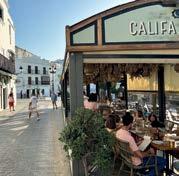
review further on).
“The opportunity came up and we thought we might try a typical Danish sandwich business and so far so good,” he adds.
I first found this culinary heaven when I landed at seminal restaurant Trafalgar (named after the nearby naval battle) on a side trip into the town centre, en route to Cadiz, nearly 20 years ago.
It stood out, appropriately, like a lighthouse in what was then something of a culinary desert.
A great mix of local and national dishes, lots with twists, led me back here a few months later when I stayed at the charming local hotel, Califa, literally right across the square. And that’s when I got the surprise of my life, it had an amazing hidden restaurant in its courtyard garden, focusing on local cuisine, as well as Moroccan fare from over the Straits.
It also turned out to have a British owner, James Stuart, a former travel guide and cycling pro, who decided he wanted to up the ante and take on his near neighbour.
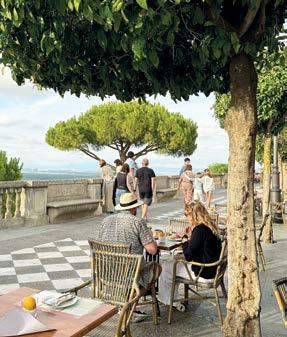
future.
“Apart from Trafalgar the food was so boring back in the early noughties,” explains the hard-working Scotsman, who now has 10 restaurants and hotels in the area. “There was no Chinese, no Indian, no Japanese, and so we hoped to do something different.
“It didn’t take long to work out that we had to open a Moroccan restaurant, particularly as all the ingredients were literally on our doorstep, with the exception perhaps of couscous.”
He continues: “The two restaurants ended up setting the standard for the


An old printers still creates leaflets, magazines and cards in
restaurant Castilleria, Campero and Antonio. And there were still some amazingly authentic places to still eat as well.
“We knew we had to match Trafalgar for service and we tried to create our own niche,” continues the father-of-two, who came to Spain to open a cycling business in the 1990s.
“From then on anyone who opened a restaurant in Vejer had to be at our level…and from about 2010 as the recession ended things started to take off.”
Within the next few years the town could count on perhaps a dozen new places to eat, including el Muro, Judería and Casa Varo, while outside town emerged meat
They included the charming, Venta el Toro, in Santa Maria, gloriously unpretentious and little wonder celebrity American/Spanish chef Jose Andres, brought his daughters here for a recent food programme.
Little changed in decades, it is one of the last genuine redoubts of quintessential Andalucia, and the food, while simple, is absolutely delicious.
But, of course, it has to be in a town that nowadays has at least a dozen amazing places to eat, the genuine melting pot of the best of Andalucia!



T’S sundowner time and a solitary kitesurfer is entertaining half the crowd assembled at the Hurricane hotel’s iconic beachside bar.
But while he’s showing off with jumps that stretch a good way towards Morocco, another more cultured half are sitting in a glade listening to flamenco.
Spread out on sofas under a stand of umbrella pines, they, like me, are being transported a long way further by a hypnotic repertoire mixed with Arabic sounds and African claps and rhythms.
A regular weekly event, the flamenco duo, a guitarist and singer, hold court with stunning aplomb.
As the sun begins to set there is a sense among the assembled throng that few places in the world offer such an atmospheric setting for music.
One of southern Spain’s most evocative hotels, the Hurricane is still doing well what it has been doing for decades.
A seminal enclave and something of a hideout for the privileged few since the 1980s, it is easy to feel like you are on a film set.
Hugging the coastline with spectacular gardens and two lovely pools, it is no wonder that guests have been coming back for years.
And they are not here for five-star polished service, but instead the charm-

ing laidback vibe, you rarely find these days on the Spanish coastline. The truth is, little has changed in decades and that is how they like it:
Most will simply saunter around in the morning before heading for the

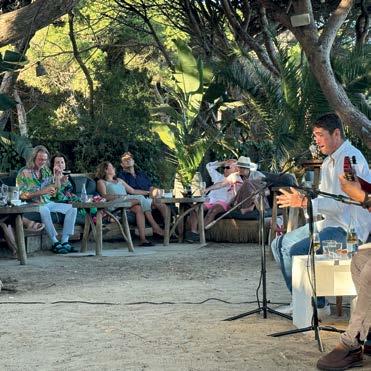

with plenty of meat and fish, particularly with tuna from the nearby area. Of course a few are looking to do some exercise and it helps that there is a proper gym and spa and you can also hire bikes, go horse riding or take a hike right from the door.
famous buffet lunch, which is heavily but not entirely vegetarian and all cooked on the premises.
In the evening they stroll out onto the main terrace, dressing up to the nines and enjoying a more formal menu
POINTING TO PUNTA
Without a doubt more appropriate to families and for those wanting space, the Punta Sur hotel half a mile up the coast is a great alternative.
Its giant circular swimming pool sits in a spectacular setting and is properly cut off from the wind, which is great on the days when the wind is really blowing as it often does around these parts. Close to Valdevaqueros beach, its

leafy grounds hide fountains, duck ponds, peacocks and even a tennis court.
There is a massage centre and recently updated gym, not to mention its pool table in the big reception area, where doz ens of amazing photos and paintings are always on display.
But best of all is its charming El Jardin restaurant, which is the classic hidden escape for a long, languid lunch or a romantic eve ning under candlelight.
Sitting in the leafy garden, just behind the main hotel, its climbing plants and roses drape a pergola which is nicely lit at night.

Even better, the menu is local and seasonal with plenty of special touches.
The local tomatoes, with fresh basil

and mozzarella are excellent, while the tuna sashimi - in a homemade ponzu sauce was the perfect starter. So so fresh.
Ivan the chef has been here a long time now and to keep up his interest he makes sure there are plenty of specials every week.
On this visit I tried his ‘marine secretos’
which was beautifully sliced bluefin tuna - half lomo and half ventresca - so tasty and succulent.
Another day I tried the Pargo, a rock fish from the area and it couldn’t have been better cooked.
My suite at the top of the garden looked out over the grounds towards the sea, with Africa in the distance behind.
I watched huge tankers steaming by and the occasional bob of a kitesurf. From here it is the most amazing walk or jog up the coast to the Hurricane hotel.
You simply hop over the main road and walk through scrub and sand dunes until you hit the beach, then take a left.
One of the most hauntingly beautiful stretches of coastline in Spain, you will likely meet nobody and the only buildings are the odd shack and a few demolished military pill boxes installed during dictator Franco’s reign.








WE are about equidistance between Spain and Morocco in the deepest part of the Straits of Gibraltar.
Flying fish, turtles and two types of whale are basking around, feeding and luxuriating in this food-rich marine paradise, some 15 minutes offshore from Tarifa.
And that’s not to mention the dolphins, including a pair of Bottlenose, who are shepherding their calf, that is apparently no
more than a week old. Soon we have found a school of dolphins swimming around the boat and, being so calm, we can see them clearly under the water.
It’s an almost religious experience for the boat-load of tourists, as the stunning mammals clearly swim over to take a closer look at us.
“These two are particularly inquisitive,” pipes up a voice from the cockpit above, as one particular pair come sniffing up to the boat, then swim underneath
at an amazing speed.
The words come from Dr Katharina Heyer, a remarkable woman of 83 years of age, who has become, without a doubt, one of the world’s authorities on sea life off the tip of southern Spain. It’s her 27th year working with her company Firmm, which was set up after she was guided to Tarifa to see whales and dolphins by a ‘spiritual man’ in 1998.
Then running her own fashion company in Switzerland, she visited the area to find nobody
organising trips to see the mam mals and almost no research on them.
“I arrived on a really rainy, awful day to find no whale boats, just fishermen, and had to rent a diving boat to take me out,” she explains.

Flying fish, dolphins and giant turtles pay a visit on a trip into the Straits
and many other fish.
It is one of the best places in the world to see them, with the currents bringing a lot of food from both directions, explains Katharina.
moved out to set up her ‘respectful whale watching’ company in Tarifa and has never looked back.
It may not have been perfect weather conditions, but what she saw completely changed her for good.
While she had long enjoyed diving holidays with her teenage sons in the Caribbean and the Maldives, seeing a group of Pilot whales and Bottle-

Indeed, so respected has been her research into the mammals over the last two decades - in particular her sensitization work for them – that in 2017 she was awarded an honorary doctorate from the University of Basel.
There are now a handful of companies taking visitors out to see the mammals from Tarifa, and on most days they can expect to see Sperm whales, Pilot whales and even Orcas, not to mention various types of dolphins
However, this brings in itself severe risks, as they are entering one of the busiest waterways in the world with more than 300 freighters and other sea traffic passing every day.
Indeed, as you look out into the Straits you are witnessing a battle for survival.
“The lives of dolphins and whales are at risk from ferries getting faster and faster, the noise from shipping traffic and more,” she explains.
“We are trying our best to monitor their numbers and do our best to minimise the issues they face.”
Visit www.firmm.org


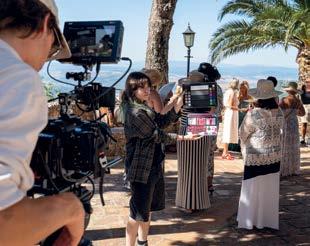
THE quiet mountain village of Gaucin has found itself in the spotlight this summer as it becomes the unlikely setting for an international feature film.
The whitewashed streets of the Andalucian pueblo, known more for its artists and writers than film crews, are now at the heart of Magdalena’s Land – a movie that explores themes of authenticity, transformation, and cultural connection.
The multinational cast and crew from Latvia, Gibraltar, the UK and America have descended to not just shoot a movie, but also bring in elements of the pueblo and its people, weaving themselves into the fabric of the local community.
“We all have different accents and I feel this mirrors society and life here in Spain because nowadays families are connected with people from everywhere,” said supporting actress Leilla Satie, praising


The Olive Press went behind the scenes of Magdalena’s Land as an international crew turns a sleepy Gaucin into a cinematic gem
By Olivia Idle
the diversity on set. “It’s a truly organic real-life story.”
Magdalena’s Land is a story of connection between people, places and the paths they have chosen and with eight Gibraltarian actors and leading Latvian star, Rezija Kalnina, playing Magdalena, the diversity on set is the film’s strength.
“The most interesting part of an international team is that all the nationalities have something different – their own way of acting and speaking and that has brought all the nationalities together,” explained producer Guna Stahovska, 51.
After two months of scouting across Andalucia, Latvian-born director, Uldis Cipsts, 51, found his answer in Gaucin describing it as ‘the true Spain with the best scenery and atmosphere in the world’.
From winding mountain roads to centuries-old homes, the village has provided more than just a backdrop for the film.
“Before coming here, everybody said if you shoot in Spain, especially as internationals, the police will come to stop the filming and ask for documents, but this hasn’t been true. Everyone has helped us,” explained Cipsts.
“People even offered to let us shoot in their homes or take their cars! Nowhere else has been as supportive and as easy to make movies.”

A transformational role
Actress, Kalnina, 54, with over 95 roles to her name and a lifetime of theatre behind her, describes her role as ‘nothing short of authentic’.
She said: “It’s a transformational role – it shows how human beings go through life and how we make decisions.”
And she told the Olive Press how fond she is of Gaucin. “You don’t have to hurry here. I love the freedom and you really have time to prepare and get ready for the next scene.”
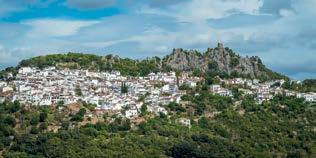

Thousands are now paying to be informed on news stories in Spain everyday
THE Olive Press website is fast becoming the go-to website for expats and tourists with any interest in what goes on in Spain.
While nearly 80,000 people have now registered an account at theolivepress.es, an incredible 2,500 are now paying for our service, with 200 alone signing up over the last month.
After significant investment and changes to our paywall provider and web server, we are now seeing between 10 to 20 people registering with us each DAY, while often more becoming paying subscribers.

HARD WORK PAYING OFF: Free sign-ups (red) are being overtaken by investment in our trusted journalism (blue) with new paying subscriptions being taken out daily
Registered users enjoy a range of benefits, including the chance to comment on stories and receive daily newsletters as well as a string of weekly newsletters.
These include travel, health and property and, as of this month, business as well as a weekend Editor’s Picks mailout.
They also get exclusive competitions, special discounts for restaurants and hotels and a comprehensive daily update keeping them informed of all key news in Spain.
Last issue we handed out two pairs of much sought after tickets for a Robert Plant concert in Granada this week.
In our special early summer discount offer last month we had 160 new annual sign ups. We will be running another special deal next month. The continued success is thanks to our crack team of NCTJ-trained journalists, who are dotted around Spain and report on the latest news from the Costa del Sol, Costa Blanca, Madrid, Balearic Islands and elsewhere.
In May our young reporter Yzabelle Bostyn won Best Young Journalist of the year award the UK NCTJ awards, beating out the Times and the Express and Star.
Our exclusive reporting is also fol lowed up by the world’s biggest news outlets, such as the line, BBC, Sky and The Telegraph, opening us up to a wider audi ence.
Please use the QR code here to register and join our growing team of loyal readers.
NO OP, NO COMMENT! BE KEPT INFORMED NO OP, NO COMMENT!





As if by mutual agreement, Andrew and Theo remained where they were, standing and sitting, saying nothing, until they heard the sound of the front door closing. Looking down, he saw that his hands were shaking again, and he felt a terrible stiffness in his neck.
“Thank you,” he said, looking up at his stepfather. “I was all over the place and you saved me.”
“From your own foolishness,” said Andrew harshly. “I assume you did throw that flashlight?”
Theo nodded. It didn’t occur to him to lie. He needed his stepfather and instinctively realized that Andrew wouldn’t be able to help him if he didn’t know the truth.
“So why did you do it?” Andrew de-
manded icily. “Because you’re an Anarchist now? Is that it?”
“No.”
“No? So you told the lieutenant the truth about that, even though the rest of what you said was lies?”
“I understand why they’re so angry about the exploitation and the injustice, but I don’t agree with what they want to do about it.”
Theo spoke slowly, trying to get his words right, refusing to be provoked by his stepfather’s angry sarcasm into a reflex response.
“The burning and the violence, you mean?” asked Andrew. “Is that what you don’t agree with?” Theo nodded.
“So why did you try to help them burn down the town hall?”

ROM Malaga they drove away from the coast across a rolling treeless plain the color of brick and yellow oxhide. The road was unsurfacedlittle more than a wide track - and they stayed in third gear, bouncing through potholes and sweating profusely in the dry heat.
The azure sea with its silver waves, lost to view behind them, seemed like a fading dream from which they had now awoken to the hard reality of a desert land. There was at most a trickle of water in the dried-out streambeds in which stunted pink and white oleander bushes clung to life alongside the ubiquitous gray-green agaves with their coarse, spiky leaves. Behind the car, a cloud of fine dust thrown up by the wheels hung in the still air like a curtain.
Sometimes they stopped to drink water and let a passing wagon drawn by a team of straining mules go by. Theo saw how the drivers shouted and cracked their whips and pitied the poor creatures anchored to their traces as they labored slowly on under the merciless hot sun.
A lifetime of uncomplaining drudgery until they finally dropped dead, leaving their carcasses behind to be sold for leather and glue.
At a crossroads, a cart brightly painted with vines and flowers and laden with
In the first of an Olive Press serialisation of Simon Tolkien’s The Palace at the End of the Sea we head back to Spain in the early 1930s, a time of great turbulence and suffering. A true journey of discovery, we follow young American protagonist Theo as he finds out about his wealthy landowner stepfather Andrew, who owns huge tranches of olive groves and orange farms in Andalucia
olives had been pulled to the side of the road under the shade of a grove of thickleaved poplars. The driver was asleep in a hammock slung between the high front wheels, while his mule slept, too, standing up with only its tail twitching involuntarily against the attentions of the flies.
A few yards farther on, a small wayside shrine made of peeling painted wood contained a chipped blue-andwhite statue of the Virgin standing on a makeshift plinth. At Elena’s insistence, they parked and went over. A small bunch of wildflowers was lying on the ground at the Virgin’s feet, wilting now in the heat, and beside it, a handwritten notice weighed down with pebbles begged passersby to pray for the soul of a child, Maria Fuentes, killed here by a madman. There was no date and no explanation. No answers to the obvious questions
that sprang into Theo’s mind - Why the killing? Why here? Just the hard, red plain stretching out on all sides baked dry by the sun. The child was dead. The madman had killed her. What was done was done. Elena crossed herself and prayed briefly before they returned to the car, leaving the driver and his mule fast asleep under the trees.
‘What do they do with all that wood? It can’t just be for themselves’
Slowly, the road started to wind and climb toward the foothills of the distant snowcapped mountains. Men and women were working in the dusty fields, bent double as they hoed, and Theo was surprised to see teams of oxen pulling wooden plows. Nothing was mechanized except their car. It was as if they were driving backward, he thought, into a biblical world that had survived unchanged since the dawn of time. They began to pass villages that appeared like splashes of white paint against the ocher-colored hills, with short columns of smoke rising into the still air above their crimson-tiled roofs. Outside one, they were stopped by a column
WE’VE all heard of stocks and bonds, and most of us have a basic understanding of what they are. Stocks represent ownership in a company, while bonds are essentially loans to a company or a government.
It’s widely recognised that it’s wise to hold both in your investment portfolio. Why? Because putting all your financial eggs in one basket is rarely a good idea – diversification helps manage risk. Even better, stocks and bonds are often negatively correlated. When stock markets dip, investors tend to seek the relative safety of bonds – which pushes up bond prices. By holding both, you can reduce volatility, aim for the same returns with less risk, and avoid emotional investing pitfalls like panic selling.
But how much of each should you hold? That’s where opinions differ.
The big question in investing –known as the asset allocation decision – has many answers. Strategies include:
● Time horizon-based: The longer you have until retirement or needing the money, the more stocks you can hold. Shorter time frames favour bonds or cash.
Why smart expats in Spain need a tailored investment strategy
● Goal-based investing: Allocate different stock/bond mixes to different goals. For example, a child’s university fund might be 50/50, while a short-term house deposit could lean 20/80.
● Target-date funds: These adjust your portfolio based on when you plan to retire, gradually shifting from stocks to bonds over time.
● Age-based: A classic rule says subtract your age from 100 (or 120) to determine the percentage to hold in stocks, with the rest in bonds.
At BISSAN Wealth Management, where I work, we take a goalbased approach. First, we learn about your financial objectives – retirement, children’s education, a property purchase – and then quantify these using our optimisation model. We calculate expected future cash needs and place those funds in bonds to shield them from market swings. The remaining capital is then invested in stocks.
Peter Dougherty
• MBA in finance
• MS in Spanish taxation
• BS in economics

• European Financial Planner in Spain
• Chartered Retirement Planning Counselor® in U.S.
• Author of two financial planning books
You might say:
“Goal-based investing has arrived in Spain.”
But there’s another wrinkle – your mortgage.
If you still owe on your home, your asset mix might not be as balanced as you think. A mortgage is essentially a

bond in reverse – instead of receiving interest, you’re paying it. Let’s say you own €200,000 in bonds and €200,000 in stocks. On paper, that looks balanced. But if you owe €150,000 on your mortgage, then the interest from a large chunk of your bonds is simply going to cover that debt. Your net bond position is only €50,000 – meaning you’re more
heavily invested in stocks than you might realise. Some may take this as a sign to buy a cheaper home in Spain and avoid a mortgage altogether. My view? Find a trusted financial advisor in Spain who can help guide you through these decisions, so
you don’t have to navigate it all alone. Same facts. Smarter conclusions.


November 29thDecember 12th 2023
Scan to visit our website
of sheep moving slowly across the road like an eddying river.
Below, a real stream defied the drought and trickled between the rocks where women with worn, leathery faces and hair tied up in kerchiefs were laundering sheets and shirts. They stopped their work and stood for a moment motionless, staring up at the car as if it were some alien visitor from another planet, and then as one went back to their washing.
“The peasant women are tough here,” said Sir Andrew, looking down. “They give birth in the morning and are back washing their husbands’ clothes in the afternoon. It’s always been the same.”

Theo saw his mother shudder. There were more people on the road now as they drove on. Women with water jugs balanced on their heads as they walked and bent-over men coming down the paths from the hills with tied-up bundles of firewood and pine cones on their backs. Some were carrying such heavy burdens that Theo couldn’t see their faces. They looked like some strange species of tree creature, he thought. Not human at all.
“What do they do with all that wood?” he asked. “It can’t just be for themselves.”
“The bakers need it to fire their ovens,” said Sir Andrew. “They give the gatherers bread in exchange. It’s not an easy life.” Such understatement! It was a terrible life, Theo thought. Not one worth living. He had never seen such work. The firewood gatherers endured worse than pack animals, who at least could stay upright under their loads. His mind reeled as he tried to imagine their
wretchedness.
“Will we be there soon?” asked Elena, whose suffering in the heat made her oblivious to the misery of others.

“Yes. Very soon. These are my orange trees,” said Sir Andrew, pointing proudly out of the window toward carefully tended groves running down the hillside as far as the eye could see in long, even lines.
“We send them to Scotland for marmalade in the spring. It’s a small business - not like the sherry - but profitable and guaranteed. The manufacturers in Dundee have to use these oranges because without them the taste changes. They tried switching to cheaper ones from Portugal in my father’s time and lost half their customers, so I think they’ve learned their lesson.

CONTRASTS: Between the local peasant farmers and the giant orange estates owned by Theo’s stepfather
“The British are connoisseurs when it comes to their marmalade.” Sir Andrew laughed, and Theo wondered what else his stepfather owned. It was another version of Spain that he seemed to be projecting: a network of flourishing business interests flowing plentiful profits through the rural economy and into his capacious pockets, completely at odds with the vision of grinding poverty that Theo had been witnessing with growing disquiet outside the car window. They passed a weathered stone
calvary in a grove of silver-leafed olive trees and a sign announcing the name of the village as LOS OLIVOS.
“Half a village and half a town,” said Sir Andrew with a wry smile. “Too big for one, too small for the other. The people have been arguing about it for years, but they can never come to a decision. So one day they are villagers and the next they are townsmen, and whatever you call them, they are insulted.”
Ahead, the village-town climbed toward the silver-domed belfry and spire of the church rising above the tessellated roofs in the shimmering sunlight, and beyond and behind that in the haze, the pine-clad foothills skirting the mountains. Higher and higher, leaving the plain behind. They drove slowly up through the narrow, winding lanes. Here, in the lower quarter, the single-story houses were no more than hovels with collapsing thatch for roofs and their once-whitewashed stucco walls fading to mottled gray, matching the faces of the inhabitants whom they passed here and there, leaning back against the crumbling masonry, staring into nothingness.
Only the children were mobile, running barefoot after the car in their dirty smocks, with their hands outstretched and white dust streaking their tousled black hair. They were shouting, but Theo couldn’t hear what they were saying through the closed windows of the car. The confining walls on either side gave way as they entered a square with a small crumbling fountain in the center, dripping water into two galvanized tin
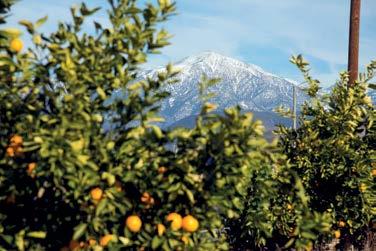
troughs, where a donkey was drinking and a girl was filling an earthenware jug.
Her face was turned away from Theo as she bent down, but she had a scarlet hibiscus flower in
her hair—a stab of unexpected color amid the monochrome townscape.
Sir Andrew stopped the car, unable to go on because their way was blocked by an overturned cart that had lost a wheel.
A sack or two of prickly pears had spilled out of the back onto the filthy cobblestones, and the children who had run after them into the square were busy picking the fruit up and dropping them as the thorns cut into their hands. The driver of the cart was yelling at them, but they paid him no attention.
Across the way, on the other side of the fountain, men in berets were drinking and playing cards at tables set up outside a small café, apparently indifferent to the commotion.
Sir Andrew wound down the window for a moment to shout at the driver to pull his cart out of the way, and Theo’s senses were immediately overwhelmed by the acrid smells of the barrio - animal excreta and urine and rancid oil and
smoke - and raucous sounds, too - a radio somewhere playing tinny flamenco, two invisible dogs carrying on a howling duet, and, closer at hand, the shrieks and cries of the children.
A few moments later the way was clear and they drove on, leaving behind the children and the girl whose face Theo had still not seen and now never would.
As the car turned out of the square, he just had time to notice a line of red graffiti reading VIVA LA ANARQUÍA, daubed on a wall that had previously been invisible behind the cart.
Looking back over his shoulder, Theo felt a secret excitement. The bent-over backs and the hollow stares of the peasantry were misleading. There was life here beneath the surface. Anarquía—he tasted the word silently on his lips, wondering who it was that had scrawled it so boldly on the wall with the trailing paint dripping down from the bottom of the letters like blood.

The problem is that Spaniards aren’t political. They’re religious. The Left just as much as the Right. They all think they’ve got God on their side. Or Marx or Bakunin or history. It doesn’t matter. What does is that they believe the people on the other side
Across: 1 Academe, 5 Vial, 7 Red Cross, 8 Uh-oh, 9 Malawi, 10 Extend, 11 Car, 12 Eric, 14 Gist, 15 OKs, 17 Aprons, 19 Purest, 21 Want, 22 Air raids, 23 Bean, 24 Descent.
Down: 1 Arena, 2 Archaic, 3 Exotic, 4 Easter, 5 Vault, 6 Abounds, 13 Replace, 14 Germane, 15 Oswald, 16 Sports, 18 Often, 20 Sadat.
are the Antichrist or the class enemy, not human beings but rabid dogs. And you don’t talk to diseased animals. You shoot them, particularly if you have a taste for violence like the people here do. Violence is where all this will end. Asturias was just the beginning.”





ACCORDING to Spanish women’s captain Peredes, the lionesses were ‘lucky throughout the Euros’. She told reporters her team was better, after losing in the penalties on Sunday.
GORDON Ramsay has declared Spanish wine ‘in another league’ and ‘one of the hidden gems of the world’ saying for this reason the Iberian Peninsula vino has been on his menus for years.
THOUSANDS of tons of invasive seaweed from Asia are piling up in Gibraltar and Spain’s southern coast. In Cadiz, they’ve removed over 1,200 tons since May.
Ryanair draws outrage for its ‘humiliating’ tone on social media
A CHEEKY tweet from Ryanair has ignited a firestorm of criticism, with some branding the low-cost carrier’s tone as downright humiliating.
The message telling passengers to ‘walk to your destination if you don’t like our rules’ – posted with a chirpy ‘buenos días’ –has drawn sharp rebuke online. It was slammed as a brazen symbol of ‘low-cost capitalism at its crudest’ by Spanish Revolution, a grassroots activist group and content producer.
The tweet comes as no surprise to those familiar with Ryanair’s no-nonsense approach, but the sarcasm has struck a nerve.
Spanish Revolution argued it’s more than just a quip, suggesting the airline is peddling ‘humiliation as part of the product’ to people who can’t afford better, urging a general boycott.
“They transport a model of the world where everything goes if it’s cheap enough,” the account
By Walter Finch
fumed, tapping into growing frustration with hidden fees and strict baggage rules that have long irked travellers.
Ryanair, a staple for Brits jetting to and from Spain’s costas, faced a €108m fine last year as part of a €179m penalty from Spanish authorities for charging for hand luggage and seat reservations – practices the airline insists keep fares low.

A 2022 European Commission study backs the discontent, revealing 68% of budget airline
A KEEN beachgoer has been caught on camera reserving his slice of paradise before the sun even had a chance to rise.
Footage from a weather cam at Playa del Cura in Torrevieja on the Costa Blanca shows the mystery man arriving at 5.36am – armed with nothing but determination and a beach umbrella. Within minutes, he was back with two sunbeds, and by 5.40am his seaside em-
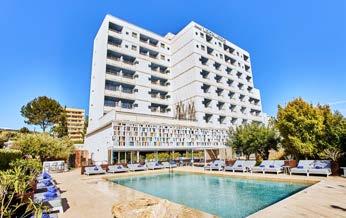



passengers feel pressured into accepting extra costs.
pire was fully established. But while his dedication is admirable (or mildly unhinged), there’s one problem – Torrevieja bans early furniture placement, with €150 fines for offenders. It seems he beat the sun... but may not outrun the town hall.
A MAN has been rescued from the Med after a bonkers attempt to cross one of the world’s busiest shipping lanes using nothing but an inflatable ring, a wetsuit and a pair of flippers.
Holidaymakers sailing off the Costa del Sol were stunned to spot what they thought was a bird or fish bobbing 20km south of Benalmadena - only to realise, through binoculars, it was a man struggling in open water.
The crew dragged him aboard and alerted Spain’s maritime rescue service. Wrapped in blankets and barely speaking, the mystery paddler had been attempting to swim from Morocco to Spain.

Your oasis by the sea.
Discover Leonardo Boutique Hotel Mallorca Port Portals - Adults Only, a 4-star superior hotel located right next to one of the most luxurious marinas of the Mediterranean: Port Portals.
Choose from one of our 77 unique rooms, all of them with great amenities and spectacular views, and enjoy a cocktail in the hotel’s Sky Bar or cool down on a Balinese bed by the pool. Come join us!